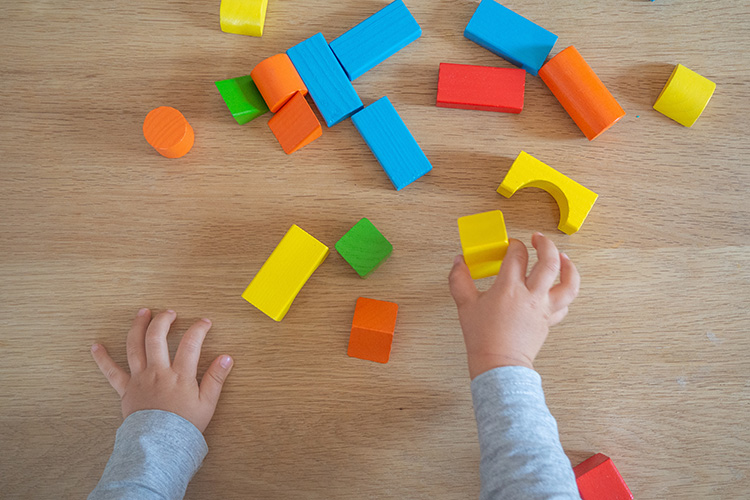Fine motor skills refer to a person’s ability to perform precise, purposeful actions with their hands, fingers, and, to a lesser extent, their toes. Because the movements can be very small, the collective term reflects the essence of coordinated motor activity.

Examples of everyday fine motor skills
Newborn babies have an unstable nervous system and only one basic skill: a firm grip on an object placed in their palm. Development of fine motor skills at different phases of childhood helps build an independent personality, which does not face daily problems. Psychologists and neurologists believe that children without opportunities to practice fine-motor skills stay extremely far behind in this regard as compared to their peers.
Fine motor activities include:
- Buttoning
- Threading a needle
- Finding a small object among a jumble of others
- Writing
- Drawing
Toys for children of various ages
Recommendations regarding the age range for which a particular fine motor toys or activity is appropriate are conditional. According to experts, each child’s growth level varies; a child could perform certain things at a very early age such as one year, while another would take over three years before attaining the same point. But, in the end, the child grows up and becomes a person.
Furthermore, experienced parents are aware that older children will occasionally willingly play with toys designed for younger children, often finding unexpected uses for them due to their developed imagination. Furthermore, very young children are frequently interested in toys for older children. Such ambitions should be encouraged by parents.
Toys for children’s fine motor skill development.
Each toy with moving parts serves a purpose in the development of fine motor activity. There are, however, toys that experts have shown to be effective more than others in developing fine motor skills:
Cubes
These are very simple items that are appropriate for children of all ages. Cubes can be either soft or hard.
The soft cubes are generally big in size and contain non-toxic, hypo-allergic elastic. They have the possibility of compressing and coming back to their original position. These types of cubes are easily put together one upon another. However, for children under one year old, simply kneading them in your hands is very beneficial. When the baby is old enough, you can invite him to throw cubes – because of their lightweight, they are completely safe, and the child will develop accuracy, an eye, and movement coordination.
Solid cubes are ideal for building towers and houses. To keep the cubes from collapsing, the child will need excellent coordination. You could hold a competition to see who can build the tallest house.
Pyramids
Toys that require you to string ring elements onto a rod in the appropriate sequence. Pyramids have many beneficial properties, but their primary function is to improve fine motor skills and coordination. Brightly colored wheels or rims will help your child learn colors. Different sizes will give an idea of the object’s spatial boundaries. Pyramids are typically made from wood or safe plastic.
Sorters
Any sorter has a simple meaning: a certain volumetric or flat toy has special slots and comes with a set of items corresponding to these slots. Classic sorters are made up of geometric shapes such as circles, squares, triangles, and ovals. Objects can also be silhouettes of fruits and vegetables, animals, automobiles, and mechanisms. The child learns the simplest logical operations by sorting the available elements.
Puzzles
Puzzles are ideal for children aged four and up. Although some children show an interest in them at a young age, they always struggle to connect the pieces. However, older children enjoy puzzles. They teach focus, observation, graphic memory, abstract reasoning, and visual search skills. Collecting various plot puzzles can also be a fun hobby for school-age children.
Drawing boards and tablets
Drawing is a form of expressing themselves. When creating even the most primitive image, the movements made with the brush and fingers develop the centers of fine motor skills, and speech, and contribute to the development of imaginative thinking. At the same time, you should not expect a small child to create masterpieces of art. Initially, it is simply the ability to hold an object that leaves a mark in your hands and move it back and forth across the paper. Graphic representation of reality is an important process that aids in the development of the child’s psyche and the formation of a world picture.
Kinetic sand
Another modern material that will appeal to children of all ages. Its unique texture, which combines the properties of real dry sand with the effect of wet sand, provides pleasure even when passing it between your fingers. Children are fascinated by the ability of such sand to fill gaps and retain shape. Kinetic sand allows you to play familiar sand games even when it’s cold outside or raining.
Busy boards
A busy board is a type of toy that consists of several elements placed on a base. Each of these elements has unique properties that may appeal to the child. The busy board may include various opening doors, windows, hatches with latches, locks and latches, various switches that, when activated, turn on the light or sound a sound signal, bells, wire loops along which stringed objects can be moved, and much more. The child constantly presses twists, opens, and moves his hands and fingers with the help of busy boards. In addition to general actions, special ones are carried out, which will be useful in everyday life.
Conclusion
It is impossible to list all of the toys that help children develop fine motor skills. Many objects can be turned into toys in a variety of situations, and parents with little creativity can significantly expand the range of objects for an interesting and useful game.
related post

Leave a Reply